Editor’s Note: The Solar Serpent in Paradise project was brought to my attention by Mans Tham, a Stockholm-based architect and urban strategist who was educated in Stockholm as well as at U.C. Berkeley. One of his post-graduate classes examined how urban life would change due to peak oil usage in Los Angeles, California, Shanghai, China, and Pune, India. In 2010, after Mans presented his project at the Beyond 2020 Symposium hosted by the Swedish Embassy in the U.S. and showcased it in a Los Angeles gallery show titled “The Fifth Ecology: Los Angeles Beyond Desire,” he was offered a scholarship to further develop his idea of the Solar Serpent Highway. In the summer of 2013, the Solar Serpent in Paradise project was a semi-finalist in one of MIT’s Climate CoLab competitions and it was judged as “very utopian.” Mans has continued to discuss the potentials of his concept with journalists and policymakers in Italy, France, Israel, and the U.S.
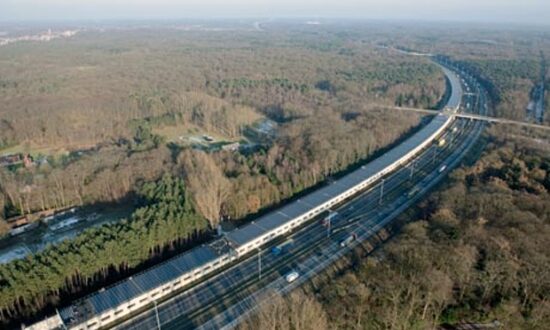
In the last few years, Europe saw its first solar powered railway infrastructure in Antwerp, Belgium. The 2.1-mile Solar Tunnel built over the railway is estimated to annually generate 3,300 MWh of renewable energy and decrease CO2 emissions by 2,400 tons. Meanwhile in London, UK, 2014 welcomed the world’s largest solar powered bridge at the newly renovated Blackfriars Train Station across the River Thames. Its new rooftop solar photovoltaic (PV) system is estimated to annually generate 935 MWh of renewable energy and decrease CO2 emissions by 511 tons.
Considering how much existing linear infrastructure systems there are, it makes sense to take advantage of the networks by mounting solar PV systems on them rather than on virgin land. Additionally, the generation of clean energy from solar PV systems is most optimized when they are installed at a large scale. Mans, we’re counting on you to implement the world’s first solar powered highway!

Solar Serpents in Paradise
Turn freeways into urban power plants! With solar-technology and a narrative design, freeways can re-emerge as contemporary structures. The Solar Serpent Highway project explores how architectural design could change both the function and the narrative of the most symbolic structure of modern society: the freeway. Even though Los Angeles provided a special inspiration for the project, the idea of transforming highways into solar corridors is applicable to most cities and regions with expensive land and lots of sun. Placement along alternative infrastructure corridors such as smaller roads, main drags, and elevated bike paths are also possible.
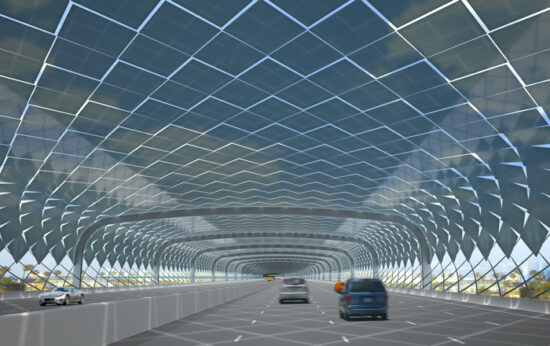
The project idea came to me as I was both fascinated and intimidated by the freeway system in LA. It is a mono-cultural place that has a huge impact on the daily life of all Angelinos. I asked myself, how can this marvelous infrastructure and symbol of the 50’s be developed to meet the demands of today? With Los Angeles County having 800 km of freeways – public land with existing points of access for maintenance – why not use some of it for large scale solar installations? Right in the middle of the city! A Solar Serpent built along the Santa Monica Freeway could generate 152 GWh per year, electricity that would be instantly sucked up in the local grid with no transmission costs or losses.
As more cars will become electrical in the future, cars can be charged at re-charging stations powered by the freeway itself. The next phase of this idea would be to install special induction lanes that charge your car while driving. For the transition period when there will be both gasoline, diesel and electric cars, I propose to direct the CO2-rich air generated from car exhaust fumes to linear algae ponds located along the freeway for local production of bio-fuels.
The big idea is to create energy, a necessity of modern life, at an industrial scale yet locally within a city. With a holistically designed infrastructure, the basic needs of a city become part of the visual cityscape. Half of the world’s population live in cities. Water and energy often come in a pipe from somewhere far away. The Solar Serpent Highway project invites the public to understand how their city works and what it takes to sustain their way of life.
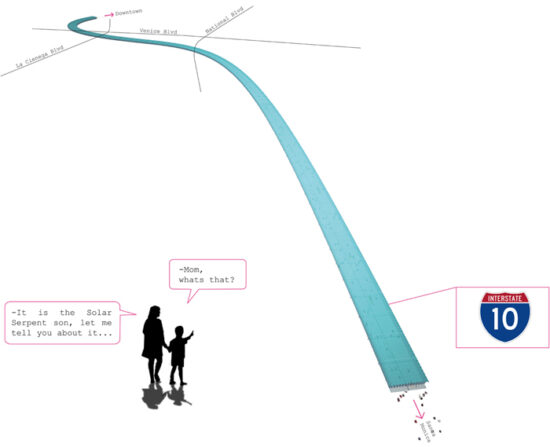
Case Study in Los Angeles: the I-10 Santa Monica Freeway
Solar panels need unshaded sun access, and that makes freeways the ideal sites. Mounted above freeway roads, solar panels would provide shade that could help decrease the use of car air conditioning on sunny days. Additionally, the solar panels would not only help drastically decrease the high repair costs of UV degradation of paved freeway surfaces, but also reduce traffic noise for people living next to the freeway.
I chose to make a case study of the 24 kilometer-long stretch of the Santa Monica freeway between the city’s downtown and the beach. On average it is 40 meters wide. This gives us a paved surface of one million square meters or 250 acres and constitutes only 5 % of LA County’s freeway system. A Solar Serpent installed over the Santa Monica freeway could house the equivalent of more than 500,000 polycrystalline, utility-scale solar panels each at 2 meters by 2 meters, and it would be become a local power plant. Note: To estimate annual production, I have used the Australian government’s estimates for solar panels (1).
- A typical utility-scaled solar panel of 2 x 2 meters has a peak capacity of 250W.
- 250W x 500,000 panels yields a maximum peak effect of 125MW for the entire system and yields an annual 1540 kWh/year/Wp for grid connected system in a location with 5.5 peak sun hours/day (LA has 5.62 peak sun hours/day).
- 1549 kWh x installed peak effect of 125 MW yields 1.9 GWh per year.
- The reduction in efficiency for horizontal mounting at 35 degrees latitude (LA is located at 34 N) is 80 to 90 percent. 190 GWh x 0.8 yields 152 GWh per year.
A frame to frame horizontal mounting of the solar panels minimizes flickering lights, which can be a road hazard. It also maximizes the number of panels per acre because no additional clearance space would be required to clear the potential shade if rows of tilted solar panels were installed.
The efficiency of a photovoltaic panel decreases rapidly in high temperature and the ventilation of the panel backside is important for avoiding efficiency losses. By mounting panels on a canopy over a freeway (compared to over a roof), ventilation on the backside is guaranteed.
If a Solar Serpent generates 152 GWh annually along the Santa Monica Freeway, it would be enough to provide the electricity needs of, for example, Venice, California with 40,000 inhabitants. Local production of electricity for local consumption in the grid minimizes transmission losses. If we replace coal-powered electricity with the renewable energy generated from the Solar Serpent, CO2 emissions would be reduced by 142,000 tonnes annually. If we replace natural gas-powered electricity, CO2 emissions would be reduced by 82,000 tonnes annually.
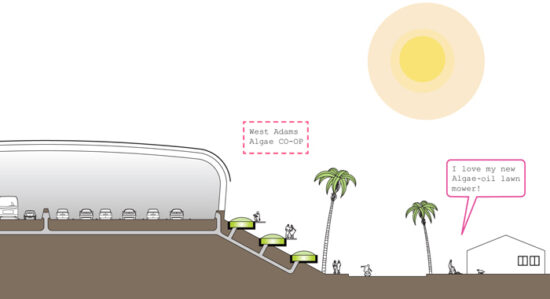
The Possibility of Algae-farming
Another resource for local energy production is the extraordinary high levels of CO2 localized on the freeways. Per a 2005 USC survey (2), the levels of CO2 on the roads and freeways of Los Angeles are between 830-950 ppm, which is sufficient for large-scale industrial algae production. This survey shows very high concentrations above the road surface and much lower concentrations in adjacent neighborhoods.
According to Professor Catherine Legrand of Linnaeus University, Kalmar, Sweden, algae can grow with the input of polluting flue gas containing CO2 but also with a mix of nitrogen oxides, sulphur and various toxic particles. She has experimented with algae farms using the flue gas from a cement plant in southern Sweden. Adding flue gas made the algae grow at the same or a higher rate and with 20-30 percent higher productivity compared to when a pure feed of CO2 is added (3).
This study indicates that the high concentration of CO2 and other gases from vehicular exhaust fumes has a potential of being used for algae production. The algae would be for bio-diesel or biomass production. Algae for health or food products would need a cleaner feed of CO2. Research on vehicular exhaust would have to be done to evaluate the potential of algae farming by the road as well as research to determine the most energy efficient way to direct the air into the algae ponds. These would be important factors in determining the feasibility of the idea.
A MIT study also shows that algae can adjust to the character of an exhaust source (4). This is relevant since the cocktail of gases differ at different segments of a freeway.
In my sketched proposal, the CO2-rich air is brought through pipes into linear covered algae ponds along the freeway. This would bring green tech jobs for farming, harvesting and processing to the very neighborhoods that today are the most disadvantaged by their proximity to the freeway. The algae farm along the Solar Serpent is a possibility that does not make or break the Solar Serpent project. It is based on a technology that is less developed than solar power but is commercially viable. Algae ponds would also only work in areas where the embankments of the freeway allow for it.
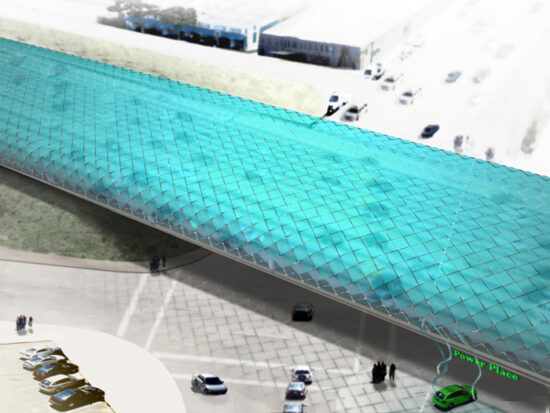
Who Will Take These Actions?
Development of a Solar Serpent Highway would be a big project, possibly a public works project that could work in several scales and would have to be implemented in stages. It would need to be a joint venture between local transport authorities, the city in which it is located, as well as a major energy producer. The benefit of also bringing in a solar panel manufacturer into the joint venture is that the solar panels could be produced, used and recycled in the same city, thus benefiting the local economy at all stages of the life-cycle of the urban solar power plant. This approach in my proposal addresses the common ambition by mayors all over the world to become a “green-tech” city.
Where Will These Actions Be Taken?
Even though the project has been designed for Los Angeles, the possibilities of replicating it elsewhere are almost endless. The freeway is a part of life throughout most parts of the world and discussions on what to do with these structures are vivid. Construct them below ground? Transform them to boulevards? Build sound barriers? Whatever one may think of freeways, the fact that freeways occupy established urban corridors is a huge advantage and potential for the distribution of the electricity that can be produced on existing urbanized land.
A city has by tradition a multilayered structure: subways, piping, high rises, shops, underground garages etc. This multi-layering should be applied to the freeways that now are relics from a modernist way of planning city spaces which is now considered as un-modern. The Solar Serpent Highway would be such a huge project that it would need public officials with strong will-power and determination. The structure of the planning process would be crucial. If Solar Serpents were to be built in cities such as Phoenix, Beijing, Abu Dhabi or Rome, each would most likely be different from each other in scale and shape due to the planning process of each city.

Architectural Benefits and the Understanding of the City
Someone called Los Angeles the Eden that lost its garden. Paradise city or not, the decayed and clogged freeways of today are no longer monuments that symbolize freedom and a promising future. The freeway system is in desperate need of a new narrative.
The Solar Serpent would give the freeways a radically different and bold presence in the city. Electrical car recharging stations along it would clearly illustrate the connection between production and usage of electricity. I believe it is easier to accept living next to an architectural wonder than a concrete sound wall.
I propose an architectural design that not only does not shy away from the monumental impact these roads have on the cityscape but also add new functions and visible layers that are coherent with today’s needs. By letting infrastructure be a visually powerful part of the city, inside and out, its citizens are allowed to understand and cherish the complexity of their daily urban life.
References
(1) “Australia’s guide to environmentally sustainable homes: 6.7 PHOTOVOLTAIC SYSTEMS ” (2010)
(2) “Mobile platform measurements of ultrafine particles and associated pollutant concentrations on freeways and residential streets in Los Angeles, Atmospheric Environment 39 (2005) 3597–3610”
(3) “Using algal technology to capture CO2 from industrial flue gas” ÅF Green Advisor Report 2012, ÅFORSK (2012)

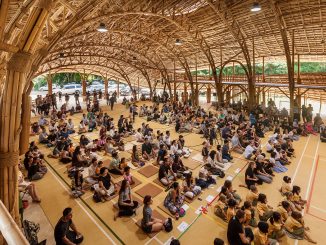
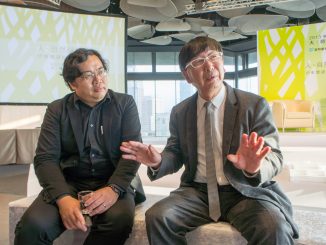
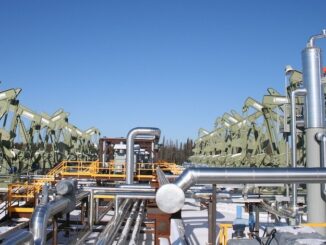
Be the first to comment